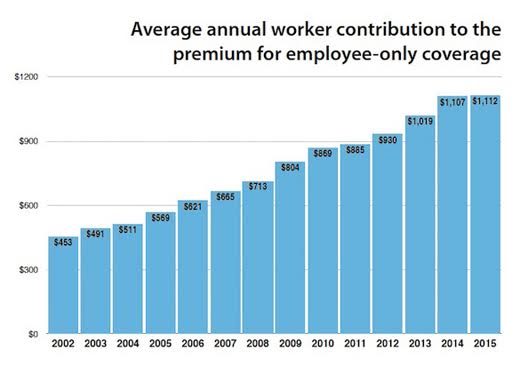
The Kaiser Family Foundation’s 17th annual nationwide employer survey confirms what most workers already feel: Health care costs are gobbling up more and more of their wages.
Employers are the principal source of health insurance in the United States, providing health benefits for about 147 million Americans who are under 65. But most workers share the cost of the medical services they use. That cost sharing can take a variety of forms, including a share of the premium deductibles, co-payments (fixed dollar amounts per visit), and co-insurance (a percentage of the charge for services).
In 2015, 57 percent of employers offer health benefits to at least some of their workers, statistically unchanged from the 55 percent in 2014. That includes 98 percent of large firms (200 or more workers) but just 47 percent of the smallest firms (three to nine workers).
Kaiser found single and family premiums for employer-sponsored health insurance rose by an average of 4 percent between 2014 and 2015. Since 2005, premiums have grown an average of 5 percent each year, down from the 11 percent annually from 1999-2005.
The average annual premium for single coverage is $6,251, of which workers on average pay $1,071 ($89 a month). The average family premium is $17,545, with workers on average contributing $4,955 ($413 a month). That means workers contribute on average 18 percent of the premium for single coverage and 29 percent for family coverage. Those percentages have remained about the same since 2000.
There are still some workers who don’t pay out-of- pocket for the employer-provided coverage: 16 percent of covered workers with single coverage and 6 percent of covered workers with family coverage work for a firm that pays 100 percent of the premium.
Since 2010, both the share of workers with deductibles and the size of the deductibles increased sharply. About 81 percent of covered workers today are in plans with a general annual deductible. And since 2010, deductibles have risen almost three times as fast as premiums and about seven times as fast as wages and inflation. For single coverage, average deductibles were $584 in 2006, $917 in 2010, and $1,318 in 2015.
Of covered workers who are admitted to a hospital, about 65 percent pay coinsurance (a percentage), while about 14 percent pay a copayment. The coinsurance rates average 19 percent. The copayment averages $308 per hospital admission.
The same goes for visits to a primary care physician’s office. There, 68 percent of covered workers have a copayment, averaging $24, and 23 percent have coinsurance, averaging 18 percent. But that was for workers. Retirees are another story. Of large firms (200 or more workers) that offer health benefits to their employees, just 23 percent offer retiree coverage in 2015. That’s down from 66 percent in 1988, and 34 percent in 2006.
Don McIntosh is Associate Editor, The Northwest Labor Press
Graph: Northwest Labor Press










